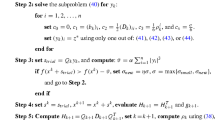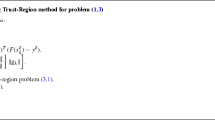Abstract
In this paper, we address the stable numerical solution of ill-posed nonlinear least-squares problems with small residual. We propose an elliptical trust-region reformulation of a Levenberg–Marquardt procedure. Thanks to an appropriate choice of the trust-region radius, the proposed procedure guarantees an automatic choice of the free regularization parameters that, together with a suitable stopping criterion, ensures regularizing properties to the method. Specifically, the proposed procedure generates a sequence that even in case of noisy data has the potential to approach a solution of the unperturbed problem. The case of constrained problems is considered, too. The effectiveness of the procedure is shown on several examples of ill-posed least-squares problems.









Similar content being viewed by others
References
Kaltenbacher, B., Neubauer, A., Scherzer, O.: Iterative Regularization Methods for Nonlinear Ill-Posed Problems, vol. 6. Walter de Gruyter, Berlin (2008)
Moré, J., Sorensen, D.: Computing a trust region step. SIAM J. Sci. Stat. Comput. 4(3), 553–572 (1983)
Donatelli, M., Hanke, M.: Fast nonstationary preconditioned iterative methods for ill-posed problems, with application to image deblurring. Inverse Probl. 29(9), 095008 (2013)
Buccini, A.: Regularizing preconditioners by non-stationary iterated Tikhonov with general penalty term. Appl. Numer. Math. 116, 64–81 (2017)
Bellavia, S., Morini, B., Riccietti, E.: On an adaptive regularization for ill-posed nonlinear systems and its trust-region implementation. Comput. Optim. Appl. 64(1), 1–30 (2016)
Hanke, M.: A regularizing Levenberg–Marquardt scheme, with applications to inverse groundwater filtration problems. Inverse Probl. 13(1), 79 (1997)
Wang, Y., Yuan, Y.: On the regularity of trust region-cg algorithm for nonlinear ill-posed inverse problems with application to image deconvolution problem. Sci. China Ser. A 46, 312–325 (2003)
Wang, Y., Yuan, Y.: Convergence and regularity of trust region methods for nonlinear ill-posed problems. Inverse Prob. 21, 821–838 (2005)
Banks, H., Murphy, K.: Estimation of coefficients and boundary parameters in hyperbolic systems. SIAM J. Control Optim. 24(5), 926–950 (1986)
Binder, A., Engl, H., Neubauer, A., Scherzer, O., Groetsch, C.: Weakly closed nonlinear operators and parameter identification in parabolic equations by Tikhonov regularization. Appl. Anal. 55(3–4), 215–234 (1994)
Deidda, G., Fenu, C., Rodriguez, G.: Regularized solution of a nonlinear problem in electromagnetic sounding. Inverse Probl. 30(12), 125014 (2014)
Henn, S.: A Levenberg–Marquardt scheme for nonlinear image registration. BIT Numer. Math. 43(4), 743–759 (2003)
Tang, L.: A regularization homotopy iterative method for ill-posed nonlinear least squares problem and its application. In: Advances in Civil Engineering, ICCET 2011, Applied Mechanics and Materials, vol. 90, pp. 3268–3273. Trans Tech Publications (2011)
Lopez, D., Barz, T., Krkel, S., Wozny, G.: Nonlinear ill-posed problem analysis in model-based parameter estimation and experimental design. Comput. Chem. Eng. 77(Supplement C), 24–42 (2015)
Landi, G., Piccolomini, E.L., Nagy, J.G.: A limited memory BFGS method for a nonlinear inverse problem in digital breast tomosynthesis. Inverse Probl. 33(9), 095005 (2017)
Cornelio, A.: Regularized nonlinear least squares methods for hit position reconstruction in small gamma cameras. Appl. Math. Comput. 217(12), 5589–5595 (2011)
Neubauer, A.: An a posteriori parameter choice for Tikhonov regularization in the presence of modeling error. Appl. Numer. Math. 4(6), 507–519 (1988)
Nocedal, J., Wright, S.: Numerical Optimization. Springer, Berlin (2006)
Buccini, A., Donatelli, M., Reichel, L.: Iterated Tikhonov regularization with a general penalty term. Numer. Linear Algebra Appl. 24(4), e2089 (2017)
Higham, N.J.: Functions of Matrices: Theory and Computation, vol. 104. SIAM, Philadelphia (2008)
Dennis, J., Schnabel, R.: Numerical Methods for Unconstrained Optimization and Nonlinear Equations. SIAM, Philadelphia (1996)
Conn, A., Gould, N., Toint, P.: Trust Region Methods, vol. 1. SIAM, Philadelphia (2000)
Allaire, G.: Numerical Analysis and Optimization: An Introduction to Mathematical Modelling and Numerical Simulation. Oxford University Press, Oxford (2007)
Engl, H., Hanke, M., Neubauer, A.: Regularization of Inverse Problems. Kluwer Academic Publishers Group, Dordrecht (1996)
Hanke, M.: Regularizing properties of a truncated Newton-CG algorithm for nonlinear inverse problems. Numer. Funct. Anal. Optim. 18(9–10), 971–993 (1997)
Kunisch, K., White, L.: Parameter estimation, regularity and the penalty method for a class of two point boundary value problems. SIAM J. Control Optim. 25(1), 100–120 (1987)
Rieder, A.: On the regularization of nonlinear ill-posed problems via inexact Newton iterations. Inverse Probl. 15(1), 309 (1999)
Scherzer, O., Engl, H.W., Kunisch, K.: Optimal a posteriori parameter choice for Tikhonov regularization for solving nonlinear ill-posed problems. SIAM J. Numer. Anal. 30(6), 1796–1838 (1993)
Riccietti, E.: Levenberg–Marquardt methods for the solution of noisy nonlinear least squares problems. PhD Thesis, University of Florence. http://web.math.unifi.it/users/riccietti/publications.html (2018)
Acknowledgements
The authors thank Gian Piero Deidda, Caterina Fenu and Giuseppe Rodriguez for providing us the MATLAB code for Problem 6.3. The authors also thank Sergio Vessella and Elisa Francini for helpful discussion on this manuscript. This work was supported by Gruppo Nazionale per il Calcolo Scientifico (GNCS-INdAM) of Italy.
Author information
Authors and Affiliations
Corresponding author
Appendix
Appendix
1.1 Proof of item (ii) of Lemma 4.2 and item (ii) of Lemma 4.4
Proof
The proof is the same for the noise-free and the noisy case; for generality, the notation of the noisy case is employed.
Since \(\lambda _k>0\) from Lemma 3.4, the trust-region is active, and from (30) it follows that
Then, if \(\Delta _k\) chosen at Step 1 of Algorithm 3.1 guarantees condition \(\pi _k(p_k)\ge \eta \), the thesis follows as
Otherwise, the trust-region radius is progressively reduced, and a bound for the value of \(\Delta _k\) at termination of Step 2 of Algorithm 3.1 can be provided. First, consider the case
Trivially,
and
By the Lipschitz continuity of \(F'\) it holds
Moreover, using (24)
for any \(\lambda \ge 0\). Consequently, as \(\Vert p_k\Vert \le \Vert B_k^{1/2}\Vert \Delta _k\) and \(\Delta _k\le C_{\max }\Vert B_k^{1/2} f'_k\Vert \),
From [22, Theorem 6.3.1 and §8.3] it holds
Then, (18) yields
whenever \(\Delta _k\le \displaystyle \frac{\Vert B_k^{1/2}f'_k\Vert }{K^4}\), and this implies
Namely, termination of the repeat loop occurs with
and
Taking into account Step 1 and the updating rule at Step 2.4, it can be concluded that, at termination of Step 2, the trust-region radius \(\Delta _k\) satisfies
In fact, in case of a smaller value of \(\Delta _k\), it happens \(f_\delta (x_k^\delta +p_k)\le \frac{1}{2}\Vert F(x_k^{\delta })-y^\delta +F'\left( x_k^{\delta }\right) p_k\Vert ^2\), then \(\pi _k(p_k)\ge 1>\eta \), and the loop at Step 2 terminates. Then, it terminates for a trust-region radius greater than or equal to the one estimated above.
Then, \(\lambda _k\le \bar{\lambda }\) as
and the thesis follows. \(\square \)
1.2 Proof of Theorem 4.3
Proof
Summing up from \({\bar{k}}\) to \(k^*(\delta )-1\), by (37), (28), (10) and Lemma 4.4, it follows
Thus, \(k^*(\delta )\) is finite for \(\delta >0\).
Convergence of \(x^\delta _{k^*(\delta )}\) to a stationary point of (1) as \(\delta \) tends to zero is obtained by adapting the proof of [5, Theorem 4.5]. Specifically, let \(x^*\) be the limit of the sequence \(\{x_k\}\) corresponding to the exact data y and let \(\{\delta _n\}\) be a sequence of values of \(\delta \) converging to zero as \(n\rightarrow \infty \). Denote by \(y^{\delta _n}\) a corresponding sequence of perturbed data, and by \(k_n = k_*(\delta _n)\) the stopping index determined from the discrepancy principle (37) applied with \(\delta =\delta _n\). Assume first that \({\tilde{k}}\) is a finite accumulation point of \(\{k_n\}\). Without loss of generality, possibly considering a subsequence, it can be assumed that \(k_n = {\tilde{k}}\) for all \(n\in \mathbb {N}\). Thus, from the definition of \(k_n\), it follows that
As, by assumption, \(\pi _k(x_{ k+1}-x_k)\ne \eta \), for all k, it follows that for the fixed index \({\tilde{k}}\), the iterate \(x_{{\tilde{k}}}^{\delta }\) depends continuously on \(\delta \). Then
Therefore, by (57), it follows that \(F'(x_{{\tilde{k}}})^*(y-F(x_{{\tilde{k}}}))=0\), and the \({\tilde{k}}\)th iterate with exact data y is a stationary point of (1), i.e. \(x^* = x_{{\tilde{k}}}\), and it is possible to conclude that \(x_{k_n}^{\delta _n}\rightarrow x^*\) as \(\delta _n\rightarrow 0\).
It remains to consider the case where \(k_n\rightarrow \infty \) as \(n\rightarrow \infty \). As \(\{x_k\}\) converges to a stationary point \(x^*\) of (1) by Theorem 4.2, there exists \(\tilde{k}>0\) such that
where \(\bar{\rho }< \min \left\{ \displaystyle \frac{(q-\sigma )\tau -K(\sigma +1)}{c(K+\tau )}, \rho \right\} \). Then, as \( x_k^\delta \) depends continuously on \(\delta \), \(\delta _n\) tends to zero and \(k_*(\delta _n)\rightarrow \infty \), there exists \(\delta _n\) sufficiently small such that \({\tilde{k}}\le k_*(\delta _n)\), and
Then, for \(\delta _n\) sufficiently small
Now, from item (i) of Lemma 4.4, it follows \(x_{\tilde{k}}^{\delta _n}\in \mathcal {B}_{2\rho }(x_{{\bar{k}}}^{\delta _n})\), while from (46) and Theorem 4.2 it holds \(x^*\in \mathcal {B}_{2\rho }(x_{{\bar{k}}}^{\delta _n})\) as
Letting \(e_k^*=x^*-x_k^{\delta _n}\). Repeating arguments from Lemma 4.3, and using (38), (2) it follows
Then, at iteration \({\tilde{k}}\), conditions (37) and (28) give
Thus, by (58) and \({\bar{\rho }} < \min \left\{ \displaystyle \frac{(q-\sigma )\tau -K(\sigma +1)}{c(K+\tau )}, \rho \right\} \), it follows that
is satisfied with \(\theta _{\tilde{k}}=\displaystyle \frac{q\tau }{1+c(1+\tau )\bar{\rho }+\sigma (1+\tau )}>1\). Replacing \(x^\dagger \) with \(x^*\), (10) gives \(\Vert x_{{\tilde{k}}+1}^{\delta _n} -x^*\Vert < \Vert x_{{\tilde{k}}}^{\delta _n} -x^*\Vert \) and repeating the above arguments, by induction monotonicity of the error \(\Vert x_k^{\delta _n} -x^*\Vert \) for \(\tilde{k}\le k \le k_n\) is obtained. Then
Finally, repeating the previous arguments, it can be shown that, for every \(0\le \epsilon \le {\bar{\rho }}\), there exists \(\bar{\delta }_\epsilon \) such that \(\Vert x_{k_n}^{\delta _n}- x^*\Vert \le \epsilon \) for all \(\delta _n\le \bar{\delta }_\epsilon \), i.e.
and the thesis is proved. \(\square \)
Rights and permissions
About this article
Cite this article
Bellavia, S., Riccietti, E. On an Elliptical Trust-Region Procedure for Ill-Posed Nonlinear Least-Squares Problems. J Optim Theory Appl 178, 824–859 (2018). https://doi.org/10.1007/s10957-018-1318-1
Received:
Accepted:
Published:
Issue Date:
DOI: https://doi.org/10.1007/s10957-018-1318-1
Keywords
- Ill-posed nonlinear least-squares problems
- Regularization
- Nonlinear stepsize control
- Levenberg–Marquardt methods
- Trust-region methods




